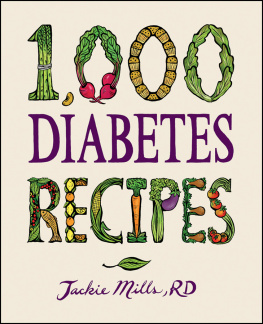Charles - How to Cook For a Diabetic: Incredible Main Dish Recipes For Diabetics
Here you can read online Charles - How to Cook For a Diabetic: Incredible Main Dish Recipes For Diabetics full text of the book (entire story) in english for free. Download pdf and epub, get meaning, cover and reviews about this ebook. year: 2012, genre: Home and family. Description of the work, (preface) as well as reviews are available. Best literature library LitArk.com created for fans of good reading and offers a wide selection of genres:
Romance novel
Science fiction
Adventure
Detective
Science
History
Home and family
Prose
Art
Politics
Computer
Non-fiction
Religion
Business
Children
Humor
Choose a favorite category and find really read worthwhile books. Enjoy immersion in the world of imagination, feel the emotions of the characters or learn something new for yourself, make an fascinating discovery.
- Book:How to Cook For a Diabetic: Incredible Main Dish Recipes For Diabetics
- Author:
- Genre:
- Year:2012
- Rating:3 / 5
- Favourites:Add to favourites
- Your mark:
- 60
- 1
- 2
- 3
- 4
- 5
How to Cook For a Diabetic: Incredible Main Dish Recipes For Diabetics: summary, description and annotation
We offer to read an annotation, description, summary or preface (depends on what the author of the book "How to Cook For a Diabetic: Incredible Main Dish Recipes For Diabetics" wrote himself). If you haven't found the necessary information about the book — write in the comments, we will try to find it.
How to Cook For a Diabetic: Incredible Main Dish Recipes For Diabetics — read online for free the complete book (whole text) full work
Below is the text of the book, divided by pages. System saving the place of the last page read, allows you to conveniently read the book "How to Cook For a Diabetic: Incredible Main Dish Recipes For Diabetics" online for free, without having to search again every time where you left off. Put a bookmark, and you can go to the page where you finished reading at any time.
Font size:
Interval:
Bookmark:
How to Cook For aDiabeticIncredible Main DishRecipes For DiabeticsElizabeth CharlesAll Rights Reserved. Nopart of this publication may be reproduced in any form or by any means,including scanning, photocopying, or otherwise without prior written permissionof the copyright holder.*Important Note*Diabetes is very seriousdisease. You should consult your physician if you are unsure if therecipes provided will fit in the diet that is recommended for the particulartype of diabetes you or your loved ones might have.2012 MJYMarketingGrabThe Entire Fast, Easy,and Delicious How to Cook For a Diabetic"Recipe Book Collection! Incredible Appetizer Recipes ForDiabetics IncredibleChili, Soup, and Stew Recipes For Diabetics Incredible Dessert Recipes ForDiabetics Incredible Salad Recipes ForDiabetics Incredible Side Dish Recipes ForDiabetics SAVE BIG: Get All6 For The Price Of 2 !!!70% SavingsLIMITEDTIME OFFER The Entire Collection Click Here for Details What people are saying aboutHow to Cook For aDiabeticIncredible Recipes ForDiabetics"Withso many friends and family that are diabetics this is a great addition to mycollection of recipes. Thanks for providing all the nutritional information soI can provide diabetic friendly dishes.""Asa diabetic I am often disappointed with the new recipes that are introduced fordiabetics; however this kindle book was a pleasant surprise! The bookcontains many quick easy to create recipes that are tasty and creative. One of my favorites is called Awesome Red Pepper Hummus Dip, and yes it wasawesome with my recent friends over on the deck. I also liked the factthat it includes all the nutritional information on every recipe; often timesthats left out.
The format is easy to read on my kindle and I hadno trouble following the directions on the recipes. Great Job!""Howto Cook For a Diabetic eBook offers a huge "easy to make" variety offoods that's healthy and tasty for everyone, not just the diabetic. Theingredients used can be found in most kitchens, unlike many specialty cookbooks I've bought. Great book!"Dedication This book isdedicated to my lovely mother. She is struggling with her diabetes and Idecided to try to give her healthy eating options. Hopefully, the recipesin this book can help her live a healthier and longer life.
She hasalready suffered permanent kidney damage. Her feet are also botheringher. The doctor is already talking about amputation. I am reallyworried about my mom. As I wasgrowing up, my mother helped me in so many ways. I wouldn't even knowwhere to start telling you how great she has been to me.
This book is myway of thanking her for always being there for me. It's my way of being a"mother" to her. Mom, I LoveYou!!! Table of Contents What is Diabetes? Diabetes mellitus, or commonly known as diabetes is a metabolicdisorder characterized by the inability of the body to utilize carbohydrateseither entirely or partially. Since carbohydrates are normally brokendown within the body in the form of glucose for the bodys main source ofenergy, diabetic conditions occur because the body is unable to use the glucosenaturally. Moreover, insulin in the pancreas is a vital hormone that isresponsible for converting glucose into energy. In diabetes, the pancreaseither cannot make enough insulin or the body is unable to respond to theinsulin that is made.
In effect, increased concentrations of glucose in theblood begin to rise which further unbalances the system and often leads tonumerous health complications. According to recent statistics by the Centers for Disease Control andPrevention (CDC), diabetes affects 8.3% of the U.S. populationand around 7.0 million people go undiagnosed. Although many people thinkdiabetes only affects the elderly there were approximately 215,000people younger than 20 years that were diagnosed with diabetes in 2010 alone.Likewise, 50% of adults aged 65 years or older have pre-diabetes. In fact, theseventh leading cause of death in the United States is diabetes. Today there are an estimated 346 million people worldwide that havediabetes and according to the World Health Association (WHO) diabetes deathswill double between 2005 and 2030.
As well, in 2004 alone there were around 3.4million people that died from high blood sugar complications. BriefHistory Diabetes mellitus has been recognized as a devastating disease forcenturies. A form of diabetes mellitus is even described by ancientEgyptians 3000 years ago from a manuscript dating back to Circa(C) 1500 Before the Common Era (BCE). Descriptions are similar to type 1diabetes and were referred to as "too great emptying of theurine." The term diabetes was first named by Aretaeus of Cappadocia(81-133 AD). Later the term mellitus was devised to separate the condition fromdiabetes insipidus which is also characterized with frequent urination. The word mellitus is a Latin derivative that means "honey sweet".As well, the word diabetes is of Latin origin meaning "a passer through;a siphon" and in turn is also derived from Greek, meaning "topass through".
It wasnt until the early 20th century wheresuccessful insulin treatments were established by Canadians Charles Best andFredrick Banting. And by the 1940s, long acting insulin neutralprotamine Hagedorn (NPH) was developed which is quite similar to what is usedtoday. Types of Diabetes There are several types of diabetes that are recognized. The three maintypes are type 1 diabetes, type 2 diabetes and gestational diabetes. Severalother types of diabetes mellitus are characterized separately from the threemain types such as cystic fibrosis-related diabetes, congenital diabetes fromgenetic imperfections of insulin secretion, steroid diabetes brought on bylarge doses of glucocorticoids and other numerous forms. Type 1 Diabetes Type 1 diabetes, formerly known as childhood-onset or insulin-dependentdiabetes is characterized by a lack of insulin producing beta cells in thepancreas.
In effect, the lack of insulin producing beta islet cells leads tothe deficiency of insulin. Type 1 diabetes is also categorized into two maintypes; idiopathic and immune-mediated. Type 1B diabetes: Idiopathic or type 1B diabetes is a disease of unknownorigin. It does not affect the autoimmune system but it does test negative forislet cell antibodies. Typically people with type 1B have insulin deficienciesand can have ketoacidosis episodes. Ketoacidosis is a high blood sugar emergencythat can be life threatening.
Symptoms include abdominal pain, nausea,vomiting, accelerated breathing and on occasional even unconsciousness. Generally, a person with type 1B diabetes does not require daily insulinbecause blood glucose levels fluctuate, although blood sugar levels need to bemonitored and checked frequently. Additionally, a diet recommended by a healthprofessional is also advised. Typically, this form of diabetes is inherited.Likewise, current studies also suggest that people who are of Asian, African orHispanic origin are more apt to have type 1B diabetes. Type 1A: Immune-mediated or Type 1A diabetes is more common than 1B andcomprises around 10% of diabetes mellitus cases in North America and Europe. Itwas also previously known as insulin-dependent and juvenile-onsetdiabetes.
Type 1A diabetes is characterized by beta cell loss due toT-cell arbitration autoimmune damage. Currently there is no known preventativemeasure for type 1A diabetes. Generally onset is not anticipated becausepatients are usually quite healthy and not overweight. This form of diabetescan be easily controlled in the early stages with a positive response toinsulin. Type 1A diabetes affects both adults and children. It waslabeled "juvenile diabetes" because children with diabetes are moreapt to have this type.
Treatment for type 1A diabetes is largely through artificial insulin byinjection combined with monitored blood sugar levels and specialized diets. Inthe early stages of the disease treatment can be orally. Oftentimes insulin is a prerequisite for type 1A diabetes and withoutregular monitored doses a person can develop diabetic ketoacidosis which mayresult in a coma or death. Furthermore, there are non-insulin treatments currently being analyzedsuch as stem-cell based therapies and monoclonal antibodies. These clinicalstudies have been effective in animals but clinical trials for humans are notyet complete. Type 1A diabetes canaffect young children and teenagers, but it can happen at any age, even someonewho is eighty or ninety years old.
Next pageFont size:
Interval:
Bookmark:
Similar books «How to Cook For a Diabetic: Incredible Main Dish Recipes For Diabetics»
Look at similar books to How to Cook For a Diabetic: Incredible Main Dish Recipes For Diabetics. We have selected literature similar in name and meaning in the hope of providing readers with more options to find new, interesting, not yet read works.
Discussion, reviews of the book How to Cook For a Diabetic: Incredible Main Dish Recipes For Diabetics and just readers' own opinions. Leave your comments, write what you think about the work, its meaning or the main characters. Specify what exactly you liked and what you didn't like, and why you think so.



















